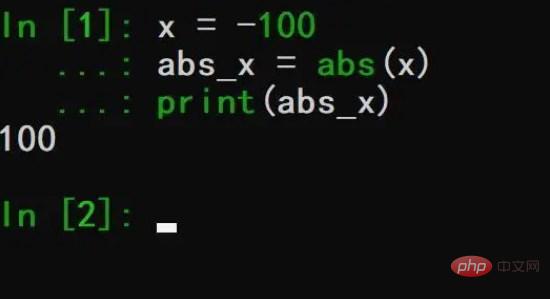How to find the absolute value in python
How to find the absolute value in Python: 1. Use Python’s built-in function “abs()” to easily calculate the absolute value of a number; 2. Use conditional statements to calculate the absolute value of a number; 3. Use Python’s The math library can use the "fabs()" function to calculate the absolute value of a number; 4. Use the numpy library in Python to calculate the absolute value of numbers and arrays using the "abs()" function; 5. Use the ternary operator in Python to calculate the absolute value of a number.

The operating environment of this article: Windows 10 system, python version 3.11.2, dell g3 computer.
How to find the absolute value in Python:
1. Use the built-in function abs()
You can easily calculate numbers using the Python built-in function abs() absolute value. For example, to calculate the absolute value of the number -100, you can use the following code:
x = -100 abs_x = abs(x) print(abs_x)
The output will be 100 as shown below

2. Use conditions Statement
We can use conditional statements to calculate the absolute value of a number. If the number is greater than or equal to 0, then its absolute value is itself. Otherwise, the absolute value is equal to its opposite. Here is a sample code:
x = -102
if x < 0:
abs_x = -x
else:
abs_x = x
print(abs_x)The output will be 102.
In [2]: x = -102
...: if x < 0:
...: abs_x = -x
...: else:
...: abs_x = x
...: print(abs_x)
1023. Use the math library
Using the math library in Python, you can use the fabs() function to calculate the absolute value of a number. So, import the math module first, and then the fabs() function returns a floating point number, even if the passed parameter is an integer. Here is a sample code:
import math x = -1024 abs_x = math.fabs(x) print(abs_x)
The output will be 1024.0 as shown below.
In [2]: import math
...: x = -1024
...: abs_x = math.fabs(x)
...: print(abs_x)
1024.04. Use the numpy library
Using the numpy library in Python, you can use the abs() function to calculate the absolute value of numbers and arrays. The following is a sample code. You can pass in a list for judgment, as shown below:
import numpy as np x = np.array([-1, 2, -3, 4,8,-6]) abs_x = np.abs(x) print(abs_x)
The output will be [1 2 3 4 8 6]. As follows.
In [5]: import numpy as np
...: x = np.array([-1, 2, -3, 4,8,-6])
...: abs_x = np.abs(x)
...: print(abs_x)
[1 2 3 4 8 6]5. Use the ternary operator
The ternary operator in Python can also be used to calculate the absolute value of a number. Here is a sample code:
x = -10086 abs_x = x if x >= 0 else -x print(abs_x)
The output will be 10086 as shown below.
In [6]: x = -10086
...: abs_x = x if x >= 0 else -x
...: print(abs_x)
10086In general, the above is a commonly used method to calculate the absolute value of a number in Python. Each method has its advantages, disadvantages and usage scenarios, and you can choose the most appropriate method according to the specific situation.
The above is the detailed content of How to find the absolute value in python. For more information, please follow other related articles on the PHP Chinese website!

Hot AI Tools

Undresser.AI Undress
AI-powered app for creating realistic nude photos

AI Clothes Remover
Online AI tool for removing clothes from photos.

Undress AI Tool
Undress images for free

Clothoff.io
AI clothes remover

AI Hentai Generator
Generate AI Hentai for free.

Hot Article

Hot Tools

Notepad++7.3.1
Easy-to-use and free code editor

SublimeText3 Chinese version
Chinese version, very easy to use

Zend Studio 13.0.1
Powerful PHP integrated development environment

Dreamweaver CS6
Visual web development tools

SublimeText3 Mac version
God-level code editing software (SublimeText3)

Hot Topics
 1378
1378
 52
52
 Python vs. C : Applications and Use Cases Compared
Apr 12, 2025 am 12:01 AM
Python vs. C : Applications and Use Cases Compared
Apr 12, 2025 am 12:01 AM
Python is suitable for data science, web development and automation tasks, while C is suitable for system programming, game development and embedded systems. Python is known for its simplicity and powerful ecosystem, while C is known for its high performance and underlying control capabilities.
 How to use Debian Apache logs to improve website performance
Apr 12, 2025 pm 11:36 PM
How to use Debian Apache logs to improve website performance
Apr 12, 2025 pm 11:36 PM
This article will explain how to improve website performance by analyzing Apache logs under the Debian system. 1. Log Analysis Basics Apache log records the detailed information of all HTTP requests, including IP address, timestamp, request URL, HTTP method and response code. In Debian systems, these logs are usually located in the /var/log/apache2/access.log and /var/log/apache2/error.log directories. Understanding the log structure is the first step in effective analysis. 2. Log analysis tool You can use a variety of tools to analyze Apache logs: Command line tools: grep, awk, sed and other command line tools.
 Python: Games, GUIs, and More
Apr 13, 2025 am 12:14 AM
Python: Games, GUIs, and More
Apr 13, 2025 am 12:14 AM
Python excels in gaming and GUI development. 1) Game development uses Pygame, providing drawing, audio and other functions, which are suitable for creating 2D games. 2) GUI development can choose Tkinter or PyQt. Tkinter is simple and easy to use, PyQt has rich functions and is suitable for professional development.
 Laravel (PHP) vs. Python: Development Environments and Ecosystems
Apr 12, 2025 am 12:10 AM
Laravel (PHP) vs. Python: Development Environments and Ecosystems
Apr 12, 2025 am 12:10 AM
The comparison between Laravel and Python in the development environment and ecosystem is as follows: 1. The development environment of Laravel is simple, only PHP and Composer are required. It provides a rich range of extension packages such as LaravelForge, but the extension package maintenance may not be timely. 2. The development environment of Python is also simple, only Python and pip are required. The ecosystem is huge and covers multiple fields, but version and dependency management may be complex.
 PHP and Python: Comparing Two Popular Programming Languages
Apr 14, 2025 am 12:13 AM
PHP and Python: Comparing Two Popular Programming Languages
Apr 14, 2025 am 12:13 AM
PHP and Python each have their own advantages, and choose according to project requirements. 1.PHP is suitable for web development, especially for rapid development and maintenance of websites. 2. Python is suitable for data science, machine learning and artificial intelligence, with concise syntax and suitable for beginners.
 The role of Debian Sniffer in DDoS attack detection
Apr 12, 2025 pm 10:42 PM
The role of Debian Sniffer in DDoS attack detection
Apr 12, 2025 pm 10:42 PM
This article discusses the DDoS attack detection method. Although no direct application case of "DebianSniffer" was found, the following methods can be used for DDoS attack detection: Effective DDoS attack detection technology: Detection based on traffic analysis: identifying DDoS attacks by monitoring abnormal patterns of network traffic, such as sudden traffic growth, surge in connections on specific ports, etc. This can be achieved using a variety of tools, including but not limited to professional network monitoring systems and custom scripts. For example, Python scripts combined with pyshark and colorama libraries can monitor network traffic in real time and issue alerts. Detection based on statistical analysis: By analyzing statistical characteristics of network traffic, such as data
 Nginx SSL Certificate Update Debian Tutorial
Apr 13, 2025 am 07:21 AM
Nginx SSL Certificate Update Debian Tutorial
Apr 13, 2025 am 07:21 AM
This article will guide you on how to update your NginxSSL certificate on your Debian system. Step 1: Install Certbot First, make sure your system has certbot and python3-certbot-nginx packages installed. If not installed, please execute the following command: sudoapt-getupdatesudoapt-getinstallcertbotpython3-certbot-nginx Step 2: Obtain and configure the certificate Use the certbot command to obtain the Let'sEncrypt certificate and configure Nginx: sudocertbot--nginx Follow the prompts to select
 How debian readdir integrates with other tools
Apr 13, 2025 am 09:42 AM
How debian readdir integrates with other tools
Apr 13, 2025 am 09:42 AM
The readdir function in the Debian system is a system call used to read directory contents and is often used in C programming. This article will explain how to integrate readdir with other tools to enhance its functionality. Method 1: Combining C language program and pipeline First, write a C program to call the readdir function and output the result: #include#include#include#includeintmain(intargc,char*argv[]){DIR*dir;structdirent*entry;if(argc!=2){



